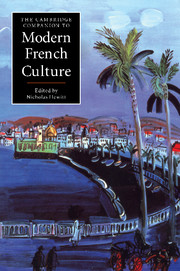Book contents
- Frontmatter
- Introduction: French culture and society in the twentieth century
- 1 Modern France: history, culture and identity, 1900-1945
- 2 Culture and identity in postwar France
- 3 Architecture, planning and design
- 4 The mass media
- 5 Consumer culture: food, drink and fashion
- 6 Language: divisions and debates
- 7 Intellectuals
- 8 Religion, politics and culture in France
- 9 The third term: literature between philosophy and critical theory
- 10 Narrative fiction in French
- 11 Poetry
- 12 Theatre
- 13 Music
- 14 The visual arts
- 15 Cinema
- Index
14 - The visual arts
Published online by Cambridge University Press: 28 May 2006
- Frontmatter
- Introduction: French culture and society in the twentieth century
- 1 Modern France: history, culture and identity, 1900-1945
- 2 Culture and identity in postwar France
- 3 Architecture, planning and design
- 4 The mass media
- 5 Consumer culture: food, drink and fashion
- 6 Language: divisions and debates
- 7 Intellectuals
- 8 Religion, politics and culture in France
- 9 The third term: literature between philosophy and critical theory
- 10 Narrative fiction in French
- 11 Poetry
- 12 Theatre
- 13 Music
- 14 The visual arts
- 15 Cinema
- Index
Summary
Introduction
France's contribution to the visual arts is arguably her outstanding achievement in the twentieth century. Paris became the world centre of modernism: the greatest non-French artists such as Pablo Picasso from Spain and Piet Mondrian from Holland would make Paris their home before the Second World War. The far-reaching impact of Cubism on architecture, from Le Corbusier onwards, changed the face of cities across the world. The Ecole de Paris saw artists from Russia, subsequently the Soviet Union, such as Chaim Soutine or Jacques Lipchitz come to live or stay for long periods in Paris, together with artists from Poland and Eastern Europe such as Jules Pascin, from Italy (Amadeo Modigliani), from Switzerland (Meret Oppenheim, Alberto Giacometti, Jean Tinguely), from Denmark (Asger Jorn) and of course from America, from the Synchronist painters before the First World War to photographers such as Man Ray and Lee Miller in the 1920s or William Klein in the 1960s.
Paris, meanwhile, reciprocated, not only as a place of freedom, bohemian lifestyles, purpose-built artists' accommodation, and the café conversation that was so essential a complement to long hours in the studio, but with a structure of annual and varied Salons, a growing, professional and internationally orientated dealer system and, in terms of both spectacle and artistic information, the great exhibitions that marked the first half of the century: the Exposition Universelle of 1900, the Exposition des Arts Décoratifs in 1925, the Exposition Coloniale in 1931, and the Exposition Internationale des Arts et des Techniques de la Vie Moderne in 1937.
- Type
- Chapter
- Information
- The Cambridge Companion to Modern French Culture , pp. 290 - 318Publisher: Cambridge University PressPrint publication year: 2003

